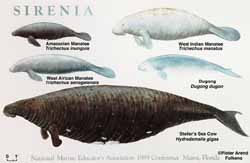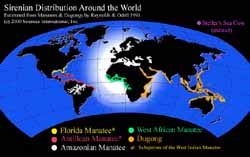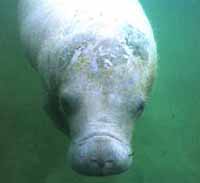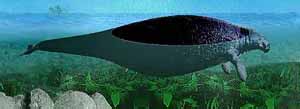
|
Frequently Asked Questions
|
What are sirenians, and why should we be concerned with their survival?
 Manatees and dugongs, also known as sea cows, are endangered species belonging to the
scientific Order Sirenia. All four living species are vulnerable to extinction from
habitat loss and other negative impacts related to human population growth and coastal
development. Manatees and dugongs are the only marine mammal herbivores. Unlike
the other marine mammals (dolphins, whales, seals, sealions, sea otters, walruses, and
polar bears) sirenians only eat seagrasses and other aquatic vegetation. Unlike
other marine mammals, sirenians have an extremely low metabolism and zero tolerance for cold
water. Like dolphins and whales, manatees and dugongs are totally aquatic mammals that
never leave the water - not even to give birth. The combination of these factors means that
sirenians are restricted to warm shallow coastal waters, estuaries, and rivers, with healthy
ecosystems that support large amounts of seagrass and/or other vegetation.
Manatees and dugongs, also known as sea cows, are endangered species belonging to the
scientific Order Sirenia. All four living species are vulnerable to extinction from
habitat loss and other negative impacts related to human population growth and coastal
development. Manatees and dugongs are the only marine mammal herbivores. Unlike
the other marine mammals (dolphins, whales, seals, sealions, sea otters, walruses, and
polar bears) sirenians only eat seagrasses and other aquatic vegetation. Unlike
other marine mammals, sirenians have an extremely low metabolism and zero tolerance for cold
water. Like dolphins and whales, manatees and dugongs are totally aquatic mammals that
never leave the water - not even to give birth. The combination of these factors means that
sirenians are restricted to warm shallow coastal waters, estuaries, and rivers, with healthy
ecosystems that support large amounts of seagrass and/or other vegetation.
Are you are concerned with conservation of biodiversity? Do you worry about
the survival of charismatic megafauna such as sea turtles, whales, gorillas, wolves,
tigers, etc.? Then you should be even more concerned with the survival of manatees and
dugongs. While there are about 78 species of cetaceans (whales & dolphins) and about 235
species of primates (monkeys, apes, chimps), there are only 4 species of sirenians living
on earth today, three manatees and one dugong. A fifth species, Steller's sea cow, was
hunted to extinction by explorers in the 1700s - read more below. Are you concerned
about the health of our oceans and estuaries? Then you should also know that Sirenians fill
a unique niche in these aquatic ecosystems. As the only living marine mammal herbivores,
they play an important roll as the largest primary consumers of seagrass and freshwater
vegetation. By protecting manatees and dugongs, we are also protecting the
coastal habitats they call home - coral reefs, mangroves, seagrasses, estuaries, and rivers. In
protecting these ecosystems, we are protecting a wide diversity of other plants and animals -
including our own species!
Until a few years ago, very few North Americans (outside of Florida) had even heard of
manatees, dugongs, or sea cows. But, as we learn more about these elusive, charismatic,
endangered, docile, and highly specialized creatures that share our coastal habitats,
they are becoming more and more popular among students, scientists, conservationists, and the
general public. For more information about sirenians,
visit "Call of the Siren", a comprehensive
resource page.
Why are sirenians an endangered species?
An endangered species is a species threatened with extinction. There are long legal definitions of the term,
but for our purposes we'll just say that if we aren't careful, our grandchildren may not enjoy the pleasure of seeing a
manatee or dugong in the wild. When this threat is human related, many of us
feel that we should seriously consider altering our activities in an effort to prevent the animal from becoming extinct. In the
case of manatees and dugongs, we
are concerned with the threat of extinction from over-harvesting and
destruction of habitat. This situation is not unique to sirenians; many plant and animal species are faced with the
same human related problems. By protecting manatees and dugongs, we are also protecting the
coastal habitats they call home - coral reefs, mangroves, seagrasses, estuaries, and rivers. In
protecting these ecosystems, we are protecting a wide diversity of other plants and animals -
including our own species!
Dugongs, West African, Amazonian, Antillean and Florida manatees have
been hunted for
subsistence (local food use) for thousands of years. Bone middens (ancient slaughter sites)
have been discovered by archeologists in Florida and Central America, indicating that
West Indian manatees were an important food source to indigenous cultures (for example, see
McKillop 1984, Prehistoric Maya Reliance on Marine
Resources: Analysis of a Midden from Moho Cay,
Belize, and McKillop 1985, Prehistoric exploitation
of the manatee in the Maya and circum-Caribbean areas).
But, it was probably large-scale commercial hunting
during the last three centuries that drastically
reduced West Indian and Amazonian manatee population numbers. Even before Russian explorers hunted Steller's sea cow to
extinction, Europeans were exploiting manatees in the Caribbean area. During the 1600s,
buccaneers purchased boatloads of manatee meat from indigenous people in Central America. In
the 1700s and 1800s, manatees were harvested commercially for meat, which was used to feed
workers on the
South American frontier and in the West Indies. During peak harvests, up to 7,000
manatees were killed every year! The Amazonian manatees were also heavily harvested for
leather and other products until 1973. Commercial hunting ceased not because people were
concerned with manatee conservation, but because populations had been reduced to such low
numbers that the mass exportation of meat was no longer economically feasible!
Are they still hunted today?
Unfortunately, illegal hunting still occurs in many locations.
Manatees and dugongs are protected at the international level, and in most countries where they
are found. We occasionally hear of manatee poaching
events in countries with strong conservation ethics, such as Belize. In other counties, illegal
hunting is a more serious threat to conservation. Hunting appears to be increasing in
Colombia (Montoya-Ospina, et al. 2001).
Illegal manatee hunting is a common occurrence in West Africa, but hunting in Guinea-Bissau
is rare. Incidental take (entanglement in fishing gear) may be the
greatest threat in Guinea-Bissau (Silva 2001).
A survey of dugongs within 37 countries and territories of its range (East
Africa to Vanuatu) has found that illegal hunting occurs in most countries
throughout the range (Marsh et al. 2001).
In many countries legislation bans dugong hunting and
they are no longer hunted deliberately, however, dugong products are still
highly valued and stimulate direct takes. Dugongs are caught for meat, oil,
medicaments, amulets and other crafts.
Dugongs in Australia have
very high cultural significance for aboriginal people and in certain places
they are legally hunted for subsistence use. The right to hunt is protected by Native Title legislation and the Torres
Strait Treaty between Australian and Papua New Guinea.
Based on aerial surveys, by Helene Marsh,
et al., the level of dugong hunting appears to be sustainable in areas such as the
northern Great Barrier Reef and Torres Strait (). In contrast, in the more urbanized southern
Great Barrier Reef coast there has been a dramatic decline in
dugong numbers in the past 50 years for many reasons, not specifically hunting.
Most indigenous groups in
this region have agreed on a moratorium on dugong hunting.
A great resource
for dugong information is the
Dugong Information Kit published online by the Great Barrier Reef Marine Park Authority.
Today, the greatest known threats to
manatees and dugongs come from competition for space with human beings. As the human
population continues to grow, more and more sirenian habitat is developed for residential,
recreational, and commercial use. Human populations are growing the fastest in coastal
areas -- in the same places that manatees and dugongs depend on for their survival. As
herbivores, sirenians must stay in shallow coastal waters or rivers where vegetation is
abundant. While illegal hunting is still an issue in some areas, development is a greater
and more widespread issue. As coastal areas are developed for human use, dredging,
wastewater discharge, and sediment run-off negatively impact manatee habitat. Seagrass
beds are destroyed by increased sedimentation. Greater human use of waterways means
increased entanglement with fishing gear and increased collisions with boats
and jet skis
for manatees. Diversion of water for human use means entrapment in culverts and canal
gates
for manatees. We know these conditions exist - but what can we do about it?
What can be done?
 Ironically, humans may be the only chance manatees and dugongs have to survive. In every
country where manatees and dugongs live, there are people working to protect them. In many
cases these are local people with very limited resources, but an enthusastic dedication to
conservation issues. While it is
obvious that humans are having a negative impact on manatee and dugong populations around the
world, it is difficult to create recovery plans without a better understanding of sirenian
ecology and behavior. That's where we "humans" can help! Scientists in Florida and Australia,
who have been studying manatees and dugongs for over three decades, are in a large part
responsible for increased public awareness and conservation programs in these areas. But
relatively little research has been
done on sirenian populations in other countries. Recovery plans for the Florida sub-species and the Australian dugong population may not be
appropriate for other species and populations in developing nations where little or no funding
is available for research, education, and conservation management. We don't even know how
many manatees and dugongs are left in the world; we only know that their numbers have been
drastically reduced in many areas. By making a tax-deductible donation to Sirenian
International, you are contributing to the research, education, and conservation efforts
necessary to protect manatee and dugong populations around the world.
Ironically, humans may be the only chance manatees and dugongs have to survive. In every
country where manatees and dugongs live, there are people working to protect them. In many
cases these are local people with very limited resources, but an enthusastic dedication to
conservation issues. While it is
obvious that humans are having a negative impact on manatee and dugong populations around the
world, it is difficult to create recovery plans without a better understanding of sirenian
ecology and behavior. That's where we "humans" can help! Scientists in Florida and Australia,
who have been studying manatees and dugongs for over three decades, are in a large part
responsible for increased public awareness and conservation programs in these areas. But
relatively little research has been
done on sirenian populations in other countries. Recovery plans for the Florida sub-species and the Australian dugong population may not be
appropriate for other species and populations in developing nations where little or no funding
is available for research, education, and conservation management. We don't even know how
many manatees and dugongs are left in the world; we only know that their numbers have been
drastically reduced in many areas. By making a tax-deductible donation to Sirenian
International, you are contributing to the research, education, and conservation efforts
necessary to protect manatee and dugong populations around the world.
MYTH: There are only 1000-2000 manatees left in Florida, today!
This myth probably evolved from early aerial survey counts. These numbers are often "thrown around" by folks
with a big heart who want to help save these docile creatures from extinction. But, in reality, this
misrepresentation actually hurts conservation efforts. The numbers are then misused by opponents to manatee
conservation initiatives to argue that the population has increased dramatically and we no longer need extensive
manatee protection. Here's the TRUTH, as we understand it: In Florida, scientists conduct "minimum
population counts" each year by counting the number of manatees aggregated in warm water
refugia on very cold days. Those numbers have ranged between 1,796 and 3,276 animals in recent
years. But, we don't know how to convert minimum counts to reliable population estimates.
We don't know for sure whether the Florida population is declining, increasing, or stabilized. The
number of manatees using areas with strong protection (like Crystal River and Blue Springs) has increased
over the past 20-30 years. At the same time, the number of manatees using areas that are highly impacted by increasing and
uncontrolled boat traffic, are probably decreasing. We also know that more and more manatees are killed each year by boats. More
information about population
monitoring and aerial surveys and
manatee mortality can be found on FMRI's webpages, http://www.floridamarine.org,
including a table of actual counts
for 1991-present.
Why do we call them sirenians?
Manatees and dugongs are named after the
Sirens of ancient Greek Mythology. In Homer's Odyssey, Sirens were half-woman, half-bird
creatures that tried to lure Odysseus and his ship onto their island with sweet songs of love.
Later, some authors confused Sirens with mermaids (mythical creatures described as half-woman,
half-fish), which eventually led to naming of the scientific Order Sirenia. Early European
explorers imaged manatees and dugongs were mermaids, possibly because of their pectoral breasts,
dexterous forelimbs, and fish-like tails. In 1493, when Columbus wrote about the "mermaids" he
had seen in the Caribbean, he commented that they were not as lovely as he had expected.
Indigenous cultures in Africa, Australia, and the
Americas each have their own unique creation story about how manatees and dugongs "came to be".
Some legends say that manatees and dugongs came from human ancestors who were transformed
into sirenians by a curse or other misfortune of living near the water.
Where do sirenians live and how long have they been around?
 The three extant manatees, the West Indian manatee (Trichechus manatus), the West
African manatee (Trichechus senegalensis), and the Amazonian manatee (Trichechus
inunguis), are found in the rivers and coastal areas of the Atlantic Ocean basin; the one
extant dugong (Dugong dugon) is found in the coastal marine areas of the Indian and
Pacific Ocean basins. The now extinct Steller's sea cow (Hydrodamalis gigas) was found
in very cold coastal waters in the northern Pacific Ocean. Today, local and international
laws protect all four living species, but they are still either threatened or endangered
everywhere they exist. Click on the map for a larger version.
The three extant manatees, the West Indian manatee (Trichechus manatus), the West
African manatee (Trichechus senegalensis), and the Amazonian manatee (Trichechus
inunguis), are found in the rivers and coastal areas of the Atlantic Ocean basin; the one
extant dugong (Dugong dugon) is found in the coastal marine areas of the Indian and
Pacific Ocean basins. The now extinct Steller's sea cow (Hydrodamalis gigas) was found
in very cold coastal waters in the northern Pacific Ocean. Today, local and international
laws protect all four living species, but they are still either threatened or endangered
everywhere they exist. Click on the map for a larger version.
The evolution of manatees and dugongs has been well studied despite the limited fossil record,
which indicates there were once many more species of sirenians, especially during the Miocene
Epoch (5-23 million years ago). Although Sirenian evolution is not fully understood,
scientists believe the order originated in the African region during the Eocene Epoch,
50-55 million years ago. The oldest known fossils were found in Jamaica (Prorastomus
sirenoides), but scientists suspect that sirenians evolved in the Old World
(Eurasia/Africa) and spread around the world's coastlines within a few million years.
Most fossil records are from the dugong family, even in the Caribbean areas where only
manatees are found today. Manatees evolved later, probably in the South American region
during the Miocene, with the oldest fossils found in Brazil and Colombia (Sirenotherium
pirabensis; Potamosiren magdalenensis). Scientists do not know for certain what caused
the decline of sirenian diversity, but we suspect some combination of climate change,
availability of aquatic vegetation, and/or competition with other marine herbivores.
The study of manatee and dugong evolution is called Sirenian Paleontology; Dr. Daryl Domning
of Howard University and his colleagues have done much of the research.
Are sirenians similar to dolphins and whales?
 Although scientists often lump sirenians together with the order Cetacea (whales and dolphins) as totally aquatic marine mammals, manatees and the dugong are actually more closely related to elephants, hyraxes, and aardvarks! This group of animals, commonly called sub-ungulates, shares an ancient African ancestor. Which makes manatees and dugongs more closely related to elephants than to dolphins or whales. In fact, scientists often find behavioral, physiological, and genetic similarities between manatees, dugongs and elephants. One major difference between cetaceans and sirenians is their diets. Whales and dolphins eat fish and plankton; some species, like the killer whale, even eat other whales and dolphins. Manatees and dugongs, like elephants, are herbivores. In fact, they are the ONLY marine mammal herbivores alive today! Their diet consists primarily of sea grasses and other aquatic vegetation. Click on image to learn more about the behavior of "The Elusive Manatee".
Although scientists often lump sirenians together with the order Cetacea (whales and dolphins) as totally aquatic marine mammals, manatees and the dugong are actually more closely related to elephants, hyraxes, and aardvarks! This group of animals, commonly called sub-ungulates, shares an ancient African ancestor. Which makes manatees and dugongs more closely related to elephants than to dolphins or whales. In fact, scientists often find behavioral, physiological, and genetic similarities between manatees, dugongs and elephants. One major difference between cetaceans and sirenians is their diets. Whales and dolphins eat fish and plankton; some species, like the killer whale, even eat other whales and dolphins. Manatees and dugongs, like elephants, are herbivores. In fact, they are the ONLY marine mammal herbivores alive today! Their diet consists primarily of sea grasses and other aquatic vegetation. Click on image to learn more about the behavior of "The Elusive Manatee".
What happened to Steller's seacow?
 Although there are only three manatee and one dugong species living today, a fifth species - the extinct Steller�s sea cow, is usually included when we talk about modern sirenians. This giant dugong-like animal was 25 feet long and weighed more than 8000 pounds. It's flukes were 7-8 feet across. Besides being huge, Steller�s sea cow was unique in other ways. It was the only sirenian that lived in cold, sub-polar waters. It had no teeth and no finger bones; and it fed on kelp (a large brown alga) instead of seagrass. The giant sirenian was discovered and described by Georg Wilhelm Steller (hence their name Steller�s sea cow) in 1741 during a voyage with Captain Vitus Bering in the North Pacific.
Bering and his two ships, St. Peter and St. Paul, were on their way home to Kamchatka following an expedition to map the coast of Alaska for Russia. The ships were separated during a storm and the St. Peter shipwrecked on an unknown island. The island was later named Bering Island in honor of the Captain who died during the winter of 1741. The crew eventually learned how to capture and kill the giant sea cow, and men finally regained enough strength to salvage and rebuild their ship. When they told others back in Kamchatka about the wonderful sea cow meat, explorers began going to Bering Island every year to provision their ships for long voyages. Unfortunately, this practice soon extirpated the species when the last sea cow was killed in 1768, only 27 years after its discovery by modern humans. This is an unfortunate example of how a small population of animals (especially long-lived, slowly reproducing animals) can be extirpated before we realize the severity of human impacts. Click on the image to visit Hans Rothauscher's Steller's sea cow webpage.
Although there are only three manatee and one dugong species living today, a fifth species - the extinct Steller�s sea cow, is usually included when we talk about modern sirenians. This giant dugong-like animal was 25 feet long and weighed more than 8000 pounds. It's flukes were 7-8 feet across. Besides being huge, Steller�s sea cow was unique in other ways. It was the only sirenian that lived in cold, sub-polar waters. It had no teeth and no finger bones; and it fed on kelp (a large brown alga) instead of seagrass. The giant sirenian was discovered and described by Georg Wilhelm Steller (hence their name Steller�s sea cow) in 1741 during a voyage with Captain Vitus Bering in the North Pacific.
Bering and his two ships, St. Peter and St. Paul, were on their way home to Kamchatka following an expedition to map the coast of Alaska for Russia. The ships were separated during a storm and the St. Peter shipwrecked on an unknown island. The island was later named Bering Island in honor of the Captain who died during the winter of 1741. The crew eventually learned how to capture and kill the giant sea cow, and men finally regained enough strength to salvage and rebuild their ship. When they told others back in Kamchatka about the wonderful sea cow meat, explorers began going to Bering Island every year to provision their ships for long voyages. Unfortunately, this practice soon extirpated the species when the last sea cow was killed in 1768, only 27 years after its discovery by modern humans. This is an unfortunate example of how a small population of animals (especially long-lived, slowly reproducing animals) can be extirpated before we realize the severity of human impacts. Click on the image to visit Hans Rothauscher's Steller's sea cow webpage.
Acknowledgments: Many thanks to Tony Stokes, Helene Marsh, Helen Penrose, Tami Gilbertson,
Katie LaCommare, Renata Santora, Nicole Auil, Ester Quintana, and Sarita Kendall, who contributed
to this article.

 (c) 2000-2005 Sirenian International, Inc.
SNAIL MAIL TO: Sirenian International, Inc., 200 Stonewall Drive, Fredericksburg, VA 22401 USA
Sirenian International, Inc. is a non-profit, tax-exempt 501(c)(3) corporation.
(c) 2000-2005 Sirenian International, Inc.
SNAIL MAIL TO: Sirenian International, Inc., 200 Stonewall Drive, Fredericksburg, VA 22401 USA
Sirenian International, Inc. is a non-profit, tax-exempt 501(c)(3) corporation.
All contributions are tax deductible within the limits of the law.
Sirenian International Logo by John Patrick Sullivan |
Website hosted by Sirenian International | Webmaster






